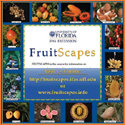FruitScapes

Lychees. UF/IFAS Photo: Thomas Wright, 2005.
Fruit trees and shrubs can be a wonderful addition to your landscape. Growing your own fruit allows you to pick everything at peak ripeness, while being able to know exactly how your food was grown. Fruit trees also provide you with shade and a little extra beauty in your garden.
State Master Gardener Volunteer Coordinator Wendy Wilber thinks growing fruit trees is a fabulous idea. "If you're going to put the effort into a tree you might as well get something from it; shade, flowers, and privacy are good, but it's always nice to get fruit," she says.
All fruit trees and shrubs need a few things to be productive. They need to be planted in an area that has full sun—between 6 and 8 hours a day—and well-drained soil in the right pH range. Take time to choose the right planting spot. Give your tree room to grow; fruit trees are more productive when their roots are not in competition with the roots of neighboring trees. Fruit trees and shrubs also need regular irrigation and fertilization to thrive. Take your location into account during selection. Deciduous trees will need the correct number of chill hours to produce fruit. If you are pushing the bounds of a tree's recommended hardiness zone, you may need to protect the plant from the cold.
Determining which tree you want to plant in your landscape can be difficult. Florida gardeners are lucky; there are a variety of tropical, sub-tropical, and temperate fruit trees that you may be able to grow in your yard. Which trees you can grow will depend on where you are located in the state, and it ranges greatly from South Florida to the Georgia border.
A Trusted Online Resource
 The UF/IFAS Tropical Research and Education Center has a wonderful website called FruitScapes that can serve as a jumping-off point, providing information for nurturing fruit trees right in your own back (or front) yard. FruitScapes has information on over 50 fruit crops that can be grown in Florida's climatic conditions.
The UF/IFAS Tropical Research and Education Center has a wonderful website called FruitScapes that can serve as a jumping-off point, providing information for nurturing fruit trees right in your own back (or front) yard. FruitScapes has information on over 50 fruit crops that can be grown in Florida's climatic conditions.
The FruitScapes website provides you with a list of resources broken up by fruit type: temperate, subtropical, and tropical, including videos that cover planting fruit trees you can grow in Florida like mango, avocado, and persimmon.
FruitScapes is an excellent resource for homeowners because it's geared towards growing fruit in the home landscape, and not as part of a large-scale agricultural operation. It provides Florida residents with current, step-by-step information on how to plant and care for fruit trees that will thrive in their region of the state.
If you've ever been curious about growing fruit in your garden, or if you already have a fruit tree or shrub, FruitScapes is a wonderful website to peruse.

